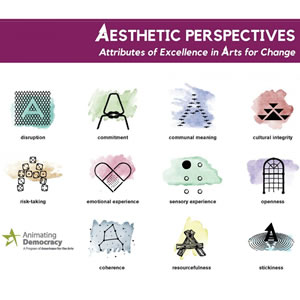Arts initiatives that seek social change often face an identity crisis: They are driven by passion, purpose, meaning, and making, but they are generally described and evaluated by more traditional measures. Worse than the challenge of a square peg in a round hole, “arts for change” projects aren’t pegs at all, but multi-dimensional efforts that defy (or are deflated by) the narrow language of program design: how many people are served, from what demographic, by what logistical process, according to what linear logic model.
 The new “Aesthetic Perspectives” framework from Animating Democracy works to expand that palette.
The new “Aesthetic Perspectives” framework from Animating Democracy works to expand that palette.
Developed by the Animating Democracy team at Americans for the Arts, in partnership with artists and their allies (see the Evaluation Learning Lab), “Aesthetic Perspectives” offers 11 attributes to help describe, understand, and evaluate “arts for change” initiatives beyond logistics, mechanics, and practical qualities:
- Commitment
Creative processes and products embody conviction to the cause espoused through the work. - Communal Meaning
The creative work facilitates collective meaning that transcends individual perspective and experience. - Disruption
Art challenges what is by exposing what has been hidden, posing new ways of being, and modeling new forms of action. - Cultural Integrity
The creative work demonstrates integrity and ethical use of material with specific cultural origins and context. - Emotional Experience
Arts for Change facilitates a productive movement between “heart space”—the emotional experience that art evokes—and the “head space” of civic or social issues. - Sensory Experience
Vivid sensations deepen the experience of the creative work and heighten the power of its messages and the potential for change. - Risk-taking
The creative work assumes risk by subverting dominant norms, values, narratives, standards, or aesthetics. - Openness
The creative work deepens impact by remaining open, fluid, transparent, subject to influence, and able to hold contradiction. - Resourcefulness
Imaginative use of available resources drives artistic innovation and demonstrates responsible social and environmental practice. - Coherence
Strong ideas expressed with clarity advance both artistic and social purposes. - Stickiness
The creative work achieves sustained resonance, impact, or value.
The framework uses a broad definition of “aesthetics” (“aesthetics is about how creative expression stimulates our senses, moves us, and makes
meaning in the world”), and seeks to broaden it further by acknowledging the historically narrow view of “excellence” and “beauty” in the institutional arts.
To support application and exploration of the framework, the report and website include “companion” essays for artists, educators, evaluators, curators, and funders.
Worth a reading, and also worth a spin on your own initiatives, to see whether and how it advances the work.


I’ve spent my career as an artist deeply involved with social justice, but something about these documents bothers me. Here’s an example:
“What values should guide evaluation of arts and social justice work? To be intentional about evaluation practices that reflect values congruent with social justice, in the accompanying table, Evaluation Learning Lab participants have framed nine values and related questions to help arts practitioners, evaluators, and funders plan and implement responsible and ethical evaluation.”
They go onto list the values:
• Shared learning and understanding • Reciprocity • Collaboration • Context • Equity • Right-sized expectations • Appropriate metrics • Ethics • Adequately resourced
It’s interesting to apply these “values” to the history of art. How would have Artaud, Genet, Mapplethorpe, Cage, Varese, Joyce, Ginsberg, Grotowski, Henry Miller, Pound, and Rivera fared under these evaluations? What about political art like Susan Crile’s images of torture at Abu Ghraib? What would have happened to surrealism, dadaism, and existentialism?
These people are exactly why the NEA is not funded, which is in effect, a suppression of the arts. Wouldn’t the criteria points listed only help to identify and eliminate genuinely subversive art — while supporting a kind of faux subversiveness? How will the NEA grow as long as subversive art is a rally cry for eliminating the agency? Isn’t the real problem not art and artists, but our administrators who are accepting a rightwing imposed mindset of suppression?
What happens to art when it is placed under the control of inevitably reductive codifications such as the above? Is this yet another example of how artistic vision is moving away from artists and being placed in the hands of administrators who censor the arts based on increasingly codified expectations and values? What will the long-term effects of this trend be?
If the government is going to “be intentional about evaluation practices that reflect values congruent with social justice,” who will define what social justice is? We see recently, for example, that concepts forbidding cultural appropriation are under strong attack. How often will the codes or “frames” of “acceptable art be changed? Is it not essential that these evaluations be made on as local of a level as possible and not by a centralized federal institution far removed from the social values of communities?
Would locally administered public funding help us avoid the monolithic aesthetic and social ideals of the 20th century such as those imposed by communism and fascism? Would America’s increasingly unmitigated, globalist capitalism be seen as a similarly totalizing social force? Won’t the most creative artists and those with the most integrity always challenge the codes and frames administrators try to impose on them, thus leaving only the collaborators funded?